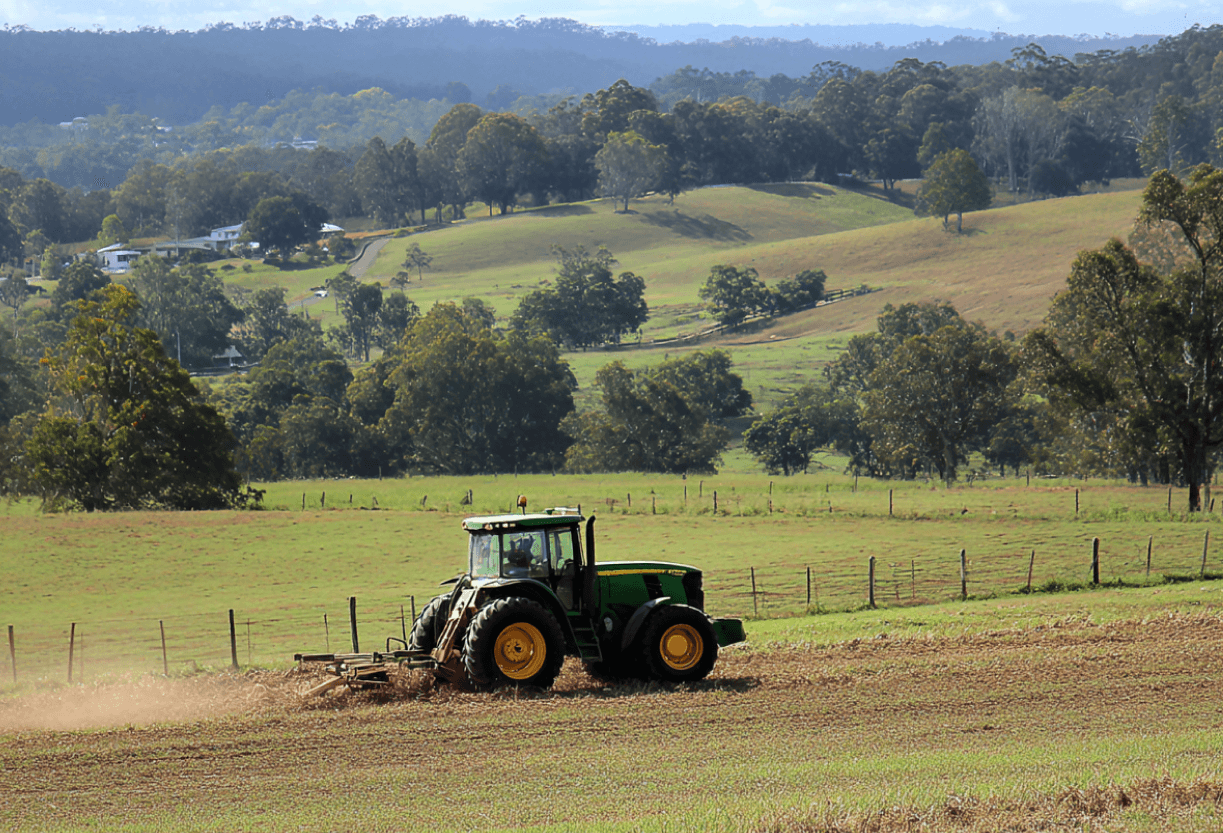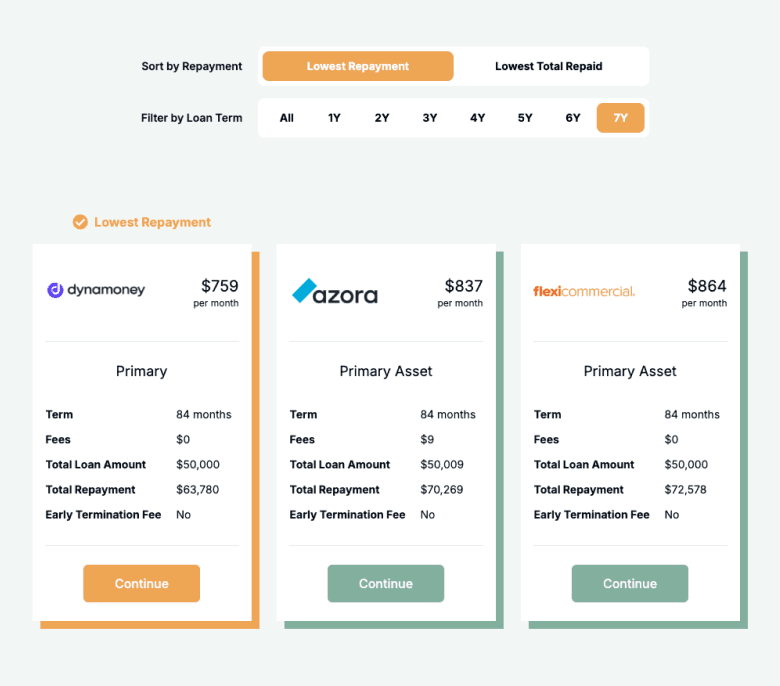Compare Farm Equipment Finance from 50+ Australian Lenders
Get tractors, harvesters and essential farm machinery without large upfront costs. Compare tailored quotes in minutes with no impact on your credit score.
5.0 rating


Farm Equipment Finance Made Simple
Finance the machinery and tools your farm needs to thrive. Designed for Australian farmers and agribusinesses looking for affordable, flexible funding.
Borrow With Confidence
Typical amounts from $10,000 to $2 million+
Flexible Terms
Loan terms from 1 to 7 years
Fast Approval
Funding often within 24–48 hours
Secured by Equipment
The asset serves as collateral for lower rates
Seasonal Repayments
Match repayments to harvest or livestock income cycles
Any Farm Purpose
From tractors to irrigation, storage and fencing
How Farm Equipment Finance Works
We connect you with lenders offering tailored farm finance so you can invest in equipment with confidence.
Apply online in minutes
Enter details about your farm and the equipment you need.
Get matched offers
Receive quotes from lenders who specialise in agricultural finance.
Choose your loan
Compare terms, rates and repayment structures to pick the right option.
Get approved & funded
Approval and funding often within 24–48 hours.

A quick guide to farm equipment finance
Farm equipment finance provides Australian farmers with the ability to purchase essential machinery without the burden of upfront costs. Instead of depleting working capital, repayments are spread over time, preserving cash for wages, feed, seed and day-to-day running expenses.
Most loans are secured against the equipment, which lowers risk for lenders and helps secure competitive interest rates. Terms typically range from 1 to 7 years, and many lenders offer seasonal repayment structures to match harvest and livestock income cycles.
Farm equipment finance can cover almost any agricultural need — from tractors and harvesters to irrigation, fencing, storage, or milking systems. Whether you’re modernising equipment, expanding production, or improving efficiency, tailored finance ensures you stay competitive.
For many Australian farmers, this finance is essential: it provides access to the latest technology, supports productivity and ensures farms remain sustainable and profitable in an industry with high capital costs.
Want to skip ahead?
This guide is broken down into the following sections. Click a link if you want to skip ahead.
Types of farm equipment finance
Here are the most common finance products farmers use to acquire equipment:
Chattel Mortgage
A secured loan where you own the asset from day one while the lender holds a mortgage over it as security. Perfect for business equipment, vehicles, and machinery purchases.
Pros
- Immediate ownership of the asset
- Tax benefits - claim GST credits and depreciation
- Flexible repayment terms available
- Lower interest rates due to security
Cons
- Asset serves as security - risk of repossession
- Comprehensive insurance typically required
- Ongoing maintenance responsibilities
Best For
Established businesses looking to purchase equipment, vehicles, or machinery with immediate ownership and maximum tax benefits.
Hire Purchase
A financing arrangement where you hire the asset with an obligation to purchase it at the end of the term. Combines the benefits of gradual ownership with manageable monthly payments.
Pros
- Guaranteed ownership at term completion
- Fixed monthly payments for budgeting
- No large upfront capital required
- Tax benefits available during the term
Cons
- No ownership until final payment made
- Higher total cost than outright purchase
- Asset cannot be sold during the term
- Early termination may incur penalties
Best For
Businesses that want eventual ownership of assets but need to spread the cost over time, particularly suitable for essential equipment with long useful life.
Finance Lease
A lease agreement where you use the asset throughout the lease term with the option to purchase it at the end. Ideal for businesses wanting to preserve cash flow while accessing essential equipment.
Pros
- Lower upfront costs and deposits
- Preserves working capital and credit lines
- Tax deductible lease payments
- Option to purchase at lease end
Cons
- No ownership until lease completion
- Total cost may be higher than outright purchase
- Early termination penalties may apply
Best For
Growing businesses that need equipment access without large capital outlay, or companies wanting to preserve cash flow for operations.
What can I use farm equipment finance for?
Farm equipment finance covers a wide range of agricultural machinery and infrastructure:
Tractors
Essential for ploughing, planting and harvesting across farms of all sizes.
Harvesters
Improve efficiency with modern harvesters for wheat, corn, soybeans and more.
Planting & Seeding
Finance precision seeders and planting equipment to boost yields.
Sprayers
Purchase fertiliser and pesticide sprayers to improve crop health and output.
Hay & Forage
Fund equipment for harvesting and storing hay and silage for livestock.
Livestock Handling
Invest in handling systems like chutes, gates and pens for safety and efficiency.
Irrigation Systems
Install or upgrade irrigation to secure reliable water supply for crops.
Grain Storage
Construct or expand grain storage facilities for post-harvest management.
Milking Equipment
Finance milking machines and tanks to support dairy operations.
Fencing & Containment
Build or upgrade fencing to keep livestock safe and secure.
Case Study

Claire Williams, Williams Family Farms
Boosting Yields with Farm Equipment Finance
Industry: Agriculture
Challenge: Outdated machinery leading to inefficiency and reduced crop yields.
Solution: A 6-year chattel mortgage secured against a new harvester and irrigation system.
Claire runs a mixed-crop farm in regional Victoria. With ageing machinery, she faced delays at harvest and uneven irrigation that reduced yields. Through Emu Money, she compared farm equipment finance options and secured a 6-year chattel mortgage for a modern harvester and irrigation upgrade. Repayments were structured to align with seasonal cash flow. The new equipment increased efficiency, boosted yields, and allowed her to expand into new crops — with predictable repayments that supported long-term planning.
How much can I borrow with farm equipment finance?
Farm equipment finance in Australia typically ranges from $10,000 for small machinery to several million dollars for specialist equipment or infrastructure. Borrowing limits depend on the equipment’s cost, age and expected life, as well as your farm’s financial profile.
Because loans are secured against the equipment, lenders can often provide higher borrowing amounts and more competitive interest rates than unsecured loans.
Farm Equipment Finance Repayment Calculator
Estimate repayments and total cost. Adjust the loan amount, term and interest rate to plan your cash flow.
Balance over time
Am I eligible for farm equipment finance?
Eligibility is generally straightforward since farm equipment is an income-producing asset. Lenders assess turnover, bank statements and repayment history when reviewing applications.
You may be eligible if you are:
An Australian citizen or permanent resident
Over 18 years old
Operating a registered farm or agribusiness
Able to provide recent bank statements
Hold an ABN (and GST registration if required)
How to apply for farm equipment finance
Apply online in minutes and get instant quotes from multiple lenders. Select your preferred option, upload documents, and funding can often be arranged within 24–48 hours.
Documents you may need:
ABN and GST registration details
Photo ID (driver’s licence or passport)
Recent business bank statements
Tax returns or financials (for larger loans)
How to save money on farm equipment finance
Saving money on farm equipment finance comes down to comparing offers and structuring terms correctly. A shorter term reduces total interest but increases repayments, while a longer term eases cash flow but costs more overall.
Many lenders offer seasonal repayment schedules that align with harvest income, reducing stress during slower months. Watch for establishment or early repayment fees, which can add up.
If your farm has strong revenue, making extra repayments can reduce interest costs over time. Aligning repayment frequency with your income cycle also helps manage cash flow effectively.
Example: $350,000 financed at 7.75% p.a.:
| Term | Repayment Amount | Total Amount to Repay |
|---|---|---|
24 months | $15,811 | $379,464 |
36 months | $10,957 | $394,452 |
48 months | $8,580 | $411,840 |
60 months | $7,079 | $424,740 |
Understanding farm equipment finance options
Farm equipment finance products differ in structure. Here are the key features to consider before applying:
Security: Asset-backed
Loans are secured against the equipment, lowering risk for lenders and improving access to better rates.
Personal Guarantee
Some lenders request a personal guarantee from the farmer or business owner.
Term: Fixed vs Seasonal
Loans usually run 1–7 years, with options for seasonal repayment schedules.
Interest Structure
Fixed rates are most common, giving predictable repayments. Variable rates are less common but available.
Fees & Charges
Establishment fees, ongoing account fees, and early termination charges may apply.
Repayment Frequency
Repayments may be weekly, monthly, or seasonal — align with your farm’s cash flow cycle.
Testimonials
Verified Review
Theodore G.
Verified Review
Sham S.
Verified Review
⭐️⭐️⭐️⭐️⭐️ Evette is amazing. As a sole trader I struggled to get finance for a car, but she worked tirelessly to make it happen and got me a great loan. Even when delays came up with the sellers bank, she kept on top of everything until it was resolved. I am so grateful and would 100% recommend her to anyone!
Sarah S.
Verified Review
I've worked with Brad for quite some time, and after 25+ years in business across Australia, I can say with confidence: professionals like him are rare, in his case, unique in the industry. Brad understands business, printers, people, and lenders better than anyone I've worked with. The advice he's given, the care he's shown, and the way he's gone above and beyond to make sure my customers get the best deal possible has made a real impact. Some of my customers haven't just grown, they have exceeded expectations. For me, that's the proof in the pudding.
Gus A.
Verified Review
Ryan was Very helpful through the entire process and made everything super simple for me. Had no issues altering and changing to suit my needs throughout
Kye Z.
Verified Review
I was so lucky to have had Evette as my broker through emu money, from the very first phone call Evette was amazing, so prompt and professional keeping me updated on the whole process of the application for finance for my new car, I highly recommend Evette!!!
Kaila B.
Frequently Asked Questions
Farm Equipment Finance FAQs
These helpful FAQs will help you find the answers you need. If you can't find what you're looking for, you can request a callback below.







































































